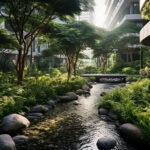Are you looking at your garden and thinking that perhaps it’s time to make some changes? Could your front yard be the center of some outdoor adventures? Then it’s time to talk about landscape.
What does it mean? What options do you have? We will answer these questions and more in this blog.
Landscape design, a definition:
As the name hints, landscape design is the practice of combining art and a bit of science to create and maintain an outdoor space in a way that’s not only beautiful aesthetically speaking but also useful. To achieve this, you need to have a clear sense of identity and purpose, so you can reflect it in your design and consider factors like the climate of the place, soil type, and what vegetation accommodates the best to your project.
There are also two concepts that you’ll need to understand.
- Hardscape elements: Anything involved that aren’t living organisms like pathways, walls, fountains, rocks, decorations, etc.
- Softscape elements: All the organic stuff: Trees, meadows, flowers, grass among others.
With this we have the basics, what’s next? Well, probably now that you have a slight idea of what landscape design is, you feel ready to start planning your garden’s makeover, but have you thought about what style you prefer?
Let’s review them
- Eco-friendly: We all care about the place where we live so it’s no surprise seeing our concern for climate change translated into recent landscape design trends. Eco-friendly landscaping is exactly that. It helps you to make planet-friendly decisions like going for plants that don’t demand tons of water or finding ways to reuse rainwater.
- English: Ever checked out the front yard of the castles while watching Bridgerton? This is the right choice for you. Sophisticated, formal, and very…British, it’s mostly composed of fancy pergolas dressed by vines, water fountains, walkways, and a lot of greenery.
- Woodland: If an English style requires a lot of maintenance, this one is definitely more carefree. Inspired by wildlife, selecting a Woodland design will transport you to enchanted forests, abundant foliage, and trees so imposing that you might feel like standing under their shadows. If your view on nature is fueled by romance, then this is your best option
- Modern: Now, the use of the word modern might have you thinking of cold spaces lacking any personality whatsoever but in reality it’s more about being a bit selective, focusing on quality rather than quantity. Defined shapes, clean areas, and plenty of divisions is what defines a modern style
So by now, you have a clearer picture of what you want to do. Is there anything else you should know?
Yes! It’s called the Six Principles of Landscape Design.
- Proportion: This is about matching all your design elements with the space as a whole.
- Transition: Following proportion, transition takes care of having everything designed in a way that there aren’t abrupt ends or mismatching elements.
- Unity: Also known as harmony, plants, and decorations should complement each other, it might be in shapes, colors, or sizes.
- Rhythm: Think about that line of trees welcoming you to your house. It looks good, right? That’s what rhythm in landscaping means, repetition.
- Balance: Following the importance of building harmony, this principle looks for a sort of equilibrium across all the elements.
- Focalization: Here, what matters is to have a center in the design, something that, regardless of the context, draws the attention of everyone.
We’ve gone over all the basics of landscape design, and you might feel ready to start on your own, that’s great but if you prefer to have some guidance, you can always rely on the help of landscape designers, so you know that the front yard of your dreams is at the hands of professionals.


